|
|
|
Sort Order |
|
|
|
Items / Page
|
|
|
|
|
|
|
| Srl | Item |
| 1 |
ID:
096522


|
|
|
| 2 |
ID:
175487


|
|
|
|
|
| Summary/Abstract |
The influential Tamil writer Pudumaippittan turned to the short story to theorise the relationship between literature and society in the late colonial era. He used the genre’s brevity to compress his portrayals of well-known female types—such as widows, prostitutes and goodwives—into singular emotional events. This enabled Pudumaippittan to evoke the wider debates about tradition and modernity that these female types commonly represented without affirming the social reformist positions to which they were linked. Through the short story, Pudumaippittan dislodged his portrayals of the Indian woman from existing gender norms, prompting a shift from social realism to modernist realism within the Tamil literary sphere.
|
|
|
|
|
|
|
|
|
|
|
|
|
|
|
|
| 3 |
ID:
147202
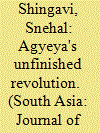

|
|
|
|
|
| Summary/Abstract |
Sachchidananda Hiranand Vatsyayan, also known as ‘Agyeya’, famously penned his three-volume modernist Hindi novel, Shekhar: Ek Jivani (Shekhar: A Life) while he was imprisoned by the British during 1930–33 for his participation in revolutionary terrorist activities. The novel, however, was incompletely published: only the first two volumes were released (in 1941 and 1944, respectively). The incompleteness of Agyeya's Shekhar manifests both writerly dissatisfaction and the transformation of the political landscape in newly independent India. Shekhar, a story of the life of a revolutionary, becomes impossible once revolution is undesired and impossible. The form of the novel, its revolutionary ambition and the construction of a writerly sensibility are all exhausted in the same moment. While revolutionary ambition is normally associated in Hindi with the realism of the All India Progressive Writers Movement (AIPWA), Agyeya's modernism was born out of aesthetic debates that he had with the poets affiliated to the AIPWA and from his Trotskyist politics.
|
|
|
|
|
|
|
|
|
|
|
|
|
|
|
|
| 4 |
ID:
174904
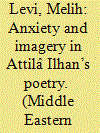

|
|
|
|
|
| Summary/Abstract |
The article offers a detailed study of the twentieth-century Turkish poet Attilâ İlhan’s early work by focusing on the use of imagery and atmosphere. The critical term in Turkish literary studies for imagery is imge and the term has acquired an unsettlingly wide semantic range since its popularization with the rise of the İkinci Yeni poetry movement in the 1950s and 60 s. İkinci Yeni's descriptive procedures continue to be the dominant influence on Turkish poetry today and this article turns the spotlight on Attilâ İlhan in order to trace alternative conceptions of imagery which were developed concurrently and in reaction to the İkinci Yeni movement. The article engages with relevant psychoanalytic and affect theories that help elucidate İlhan's use of anxiety as a socially and poetically constitutive force.
|
|
|
|
|
|
|
|
|
|
|
|
|
|
|
|
| 5 |
ID:
122050
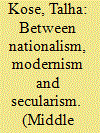

|
|
|
|
|
| Publication |
2013.
|
| Summary/Abstract |
This study discusses the position of Alevi identity and Alevi community with regard to the Turkish national identity-building project. There was a partial compatibility between the Kemalist objective of laicization and nation building and the Alevi practice and understanding of a 'local' version of 'Turkish Islam'. Besides these compatibilities, Alevis faced the challenges of nation-building and homogenization policies, which involved homogenization in ethnic, religious and sectarian domains. Kurmanji- and Zazaki-speaking ethnically Kurdish/Zaza Alevis of Eastern Anatolia had a different experience during the project of centralization and ethnic homogenization, in comparison to Turkish-speaking Turcoman Alevis. This different experience still is a source of division among Alevi communities.
|
|
|
|
|
|
|
|
|
|
|
|
|
|
|
|
| 6 |
ID:
144723
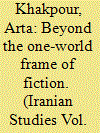

|
|
|
|
|
| Summary/Abstract |
The debate over political commitment in Iran was never limited to adjudicating content: it was frequently a debate over form as well. In the realm of fiction, this debate fixated on realism, the nature of mimesis, and the autonomy of art and the literary text. Within a few short years after forming the iconoclastic journal Jong-e Esfahan in 1965 with a group of likeminded colleagues, the writer Hushang Golshiri had become the preeminent modernist fiction writer in Iran. His critical essays represented a passionate defense of aesthetic autonomy at a time when realism and, particularly, socialist and “engaged” literature were powerful shibboleths in the Tehran literary scene. This paper begins with a look at Golshiri's critical interventions in this debate and then moves on to show how the short stories he produced in the Jong era were an even more integral part of his response to the mimesis question. By reading his stories with a methodology drawn from “possible worlds” theories of narratology, Todorov's fantastic, and Golshiri's own theories, we see how these works break down the “one-world” frame of reality that realism takes for granted, and require the reader to grapple with multiple, often contradictory, possible realities in its stead.
|
|
|
|
|
|
|
|
|
|
|
|
|
|
|
|
| 7 |
ID:
027929
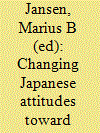

|
|
|
|
|
| Publication |
Princeton, Princeton University Press, 1965.
|
| Description |
x, 546p.
|
| Series |
Studies in the modernization of Japan
|
|
|
|
|
|
|
|
|
|
|
|
Copies: C:1/I:0,R:0,Q:0
Circulation
| Accession# | Call# | Current Location | Status | Policy | Location |
| 000256 | 303.440952/CHA 000256 | Main | On Shelf | General | |
|
|
|
|
| 8 |
ID:
167206


|
|
|
|
|
| Summary/Abstract |
Kawabata Yasunari (1899–1972) held a deep interest in modern spiritualism and applied his knowledge of it to his literary process in diverse ways. Spiritualism was widely employed as metaphor and narrative methodology in twentieth-century literary modernism, and Kawabata stood out among his peers for his prolific use of it. It has typically been assumed that Kawabata distanced himself from modernism after World War II, enacting a complete return to ‘Japanese tradition’. Yet modernist and spiritualist connections can still be observed in his writing during that period. This paper looks at the connections between postwar Kawabata and contemporary modernism, focusing in particular on a close reading of the short story ‘Mugon‘ [Silence] (1953). The story is framed by an episode involving a haunted tunnel and depicts a series of events as a novelist visits an elderly writer who has fallen mute due to illness. Kawabata uses stream-of-consciousness narration to present radical ideas about literary composition and the relationship between language and reality and subverts common-wisdom understandings of language and literature. I conclude that the composition of ‘Mugon‘ demonstrates clear continuity between Kawabata’s pre- and postwar writings.
|
|
|
|
|
|
|
|
|
|
|
|
|
|
|
|
| 9 |
ID:
096527


|
|
|
| 10 |
ID:
103140


|
|
|
|
|
| Publication |
2009.
|
| Summary/Abstract |
The generally accepted narrative for the birth of the modern Uyghur nation suggests that a national ideal for the Uyghur people and the use of the 'Uyghur' ethnonym in the modern context were creations of Soviet bureaucrats in the 1920s that were later promoted among Uyghurs in Xinjiang by Chinese authorities with Soviet sympathies. This article challenges this view by drawing on Uyghur language sources, which demonstrate the agency of Uyghur intellectuals in the creation of the concept of a modern Uyghur nation during the early twentieth century. In examining the activities of Uyghur intellectuals in fostering a modern Uyghur national identity, the article emphasizes the role of anti-colonial sentiments in this movement, thus linking the Uyghur example to post-colonial scholarly arguments about the development of modern national consciousness among formerly colonized peoples around the world.
|
|
|
|
|
|
|
|
|
|
|
|
|
|
|
|
| 11 |
ID:
187120
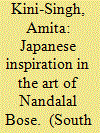

|
|
|
|
|
| Summary/Abstract |
This article explores the impact of Japanese art and its techniques on the work of Nandalal Bose (1882–1966), one of India’s pre-eminent artists, by locating specific influences from leading Japanese artists of his era, with whom he had close associations during his lifetime. It builds a case for the argument that despite being a staunch advocate for indigenous aesthetics, the depth and versatility of Nandalal’s artistic oeuvre was rooted in his ability to absorb select practices from other artistic cultures, specifically the Japanese, enabling us to connect the origins of India’s modernistic art practices principally to him. The article draws attention to the stylistic and ideological learning that he acquired during interactions with master artists from Japan, including Yokoyama Taikan, Hishida Shunsō and Arai Kanpō and demonstrates the significance of these Japanese influences to both Nandalal’s artistic life and, as a direct result, to the stylistic direction taken by Indian art in the mid-twentieth century.
|
|
|
|
|
|
|
|
|
|
|
|
|
|
|
|
| 12 |
ID:
114018
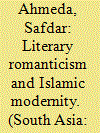

|
|
|
|
|
| Publication |
2012.
|
| Summary/Abstract |
In the nineteenth century, Muslim modernist reformers sought to ground an agenda for social and political rejuvenation in a return to the spirit of the early Muslim community. However, the influence of this quest for communal regeneration on theological discourses was, in some cases, less notable than its influence upon projects for cultural and social reform. One area of focus for Indian modernists of the nineteenth century was literature and the literary arts, including poetry, which were now deemed relevant to notions of cultural health, authenticity and decline. Under the dictum that a people's condition is reflected in their language, the themes of moral degeneration and reform came to have a strong bearing on the indigenous valuation of poetry and the literary arts, challenging the criteria upon which such literature was judged. In this paper, I will analyse how the modernist agenda for social reform led to the birth of a new literary romanticism in Urdu poetry.
|
|
|
|
|
|
|
|
|
|
|
|
|
|
|
|
| 13 |
ID:
037599


|
|
|
|
|
| Publication |
New York, Basic Books Incorporation, 1972.
|
| Description |
ix, 160 p.
|
|
|
|
|
|
|
|
|
|
|
|
Copies: C:1/I:0,R:0,Q:0
Circulation
| Accession# | Call# | Current Location | Status | Policy | Location |
| 022239 | 303.4/LEV 022239 | Main | On Shelf | General | |
|
|
|
|
| 14 |
ID:
138247
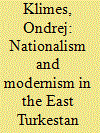

|
|
|
|
|
| Summary/Abstract |
This study explains the intellectual history and ideology of the Turkic insurgency and the East Turkestan Republic in Kashgar in 1933–34. Texts in periodicals from the period suggest that the insurgency was defined by its intellectual elites more as a nationalist enterprise than as a religious one. The insurgency’s ideologists established important national attributes of the East Turkestani nation, particularly its national name, homeland, symbology, and history, and they also articulated East Turkestani national interests, particularly political independence, representative government, and modernization. Regardless of the arguably low degree of social penetration of the ideas of the elites among common society and the small extent to which policy was actually implemented, the intertwining of East Turkestani national identity and interests with political self-government and modernization was an ideological concept that had a profound impact on all subsequent administrations in Xinjiang.
|
|
|
|
|
|
|
|
|
|
|
|
|
|
|
|
| 15 |
ID:
152636
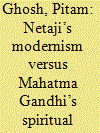

|
|
|
|
|
| Summary/Abstract |
Subhas Chandra Bose, being a Secularist, had an attitude of impartiality towards all religions. According to him, the Government of Free India must have an absolutely neutral and impartial attitude towards all religions and leave it to the choice of every individual to profess or follow a particular religion of his faith; Religion is a private affair, it cannot be made an affair of the State.
|
|
|
|
|
|
|
|
|
|
|
|
|
|
|
|
| 16 |
ID:
178777
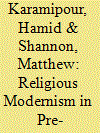

|
|
|
|
|
| Summary/Abstract |
The advent of “modern” education in Iran and its acceptance by political and cultural elites dates to the Qajar era. But the elitist nature of state reforms prevented modern education from spreading throughout society until the Pahlavi era. Especially during the reign of Mohammad Reza Shah Pahlavi, modern education reached most segments of the population, including religious families from the middle classes. This research is based on Persian-language documents and informed by the English-language historiography. The article finds that the Islamic Education Society (Jāmeʿeh-ye taʿlimat-e eslāmi) propagated religious modernism through a national network of private schools beginning in the 1940s. In the 1950s and 1960s private cultural foundations used the Islamic Education Society’s model to establish the Alavi, Kamāl, and Refāh schools in Tehran. The network that supported them was a reflection of the revolutionary movement and a vehicle for its organization by the 1970s.
|
|
|
|
|
|
|
|
|
|
|
|
|
|
|
|
| 17 |
ID:
084899
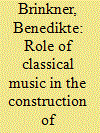

|
|
|
|
|
| Publication |
2008.
|
| Summary/Abstract |
Very little research has been conducted into the relationship between classical music and nationalism. This is a shame as music has played a significant role in the construction and consolidation of nationalism in many European countries. This article illustrates this by analysing the role of classical music and, in particular, contemporary serious music in the construction of Danish consensus nationalism in the 1930s and 1940s. In so doing, it explores the repression of the modernist expression which was and still is considered a Continental European phenomenon in favour of a local and traditional expression. Furthermore, it analyses the elevation of Carl Nielsen to the position of Danish composer par excellence.
|
|
|
|
|
|
|
|
|
|
|
|
|
|
|
|
| 18 |
ID:
154101
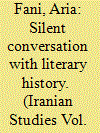

|
|
|
|
|
| Summary/Abstract |
Episodic approaches may point in the direction of general trends by examining the ideological presuppositions of dominant literary discourses. However, they necessarily reduce the aesthetic complexity of literary movements and fail to critically consider poets whose vision may not directly speak to common literary trends. Poets such as Bizhan Jalāli (d. 1999) have been rendered standalone figures whose visions of poetic modernism are understood only in the context of their “non-adherence” to the dominant literary discourse of their time or are overlooked altogether. This essay examines how the literary life and reception of Bizhan Jalāli intersect with the intellectual and aesthetic underpinnings of committed circles in the 1960s and 1970s. The twists and turns of Jalāli’s poetics do not speak directly but rather laterally to committed articulations of modernism. The article returns Jalāli to his literary milieu by analyzing the way his work has been received by poets, anthologists and critics. As the contours of literary commitment drastically change in the 1980s and 1990s, another image of Jalāli emerges: once marginalized for his “non-commitment,” he is championed as an “apolitical” poet.
|
|
|
|
|
|
|
|
|
|
|
|
|
|
|
|
| 19 |
ID:
029409
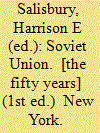

|
|
|
|
|
| Edition |
1st ed.
|
| Publication |
New York, Harcourt, Brace and world, Inc., 1967.
|
| Description |
xxii, 484p.hbk
|
|
|
|
|
|
|
|
|
|
|
|
Copies: C:1/I:0,R:0,Q:0
Circulation
| Accession# | Call# | Current Location | Status | Policy | Location |
| 015741 | 947.084/SAL 015741 | Main | On Shelf | General | |
|
|
|
|
| 20 |
ID:
114661


|
|
|
|
|
| Publication |
2012.
|
| Summary/Abstract |
This essay argues that the building of Angelo da Fonseca's critical fortune as a Christian artist from the 1930s to the 1950s was simultaneously and necessarily the building of his later misfortune and oblivion as a modern artist. Angelo da Fonseca was characterised as a Catholic painter during the first half of the twentieth century after the advice to 'paint churches' purportedly given to him by Rabindranath Tagore (or perhaps his nephew, Abanindranath Tagore). At the time, there was a generalised movement for the creation of a new Christian art involving many artists from all over the world. They too have vanished from art history's printed memory. This was due to modernism's exclusion of Christianity as a subject, which made it impossible for historians and critics to deal with twentieth-century Christian art. This, it will be argued, eventually led to a further exclusion: Indian Christian art was seen as simultaneously un-modern and un-Indian and was, therefore, omitted from the process played by the arts in India's nation-building.
|
|
|
|
|
|
|
|
|
|
|
|
|
|
|
|
|
|
|
|
|